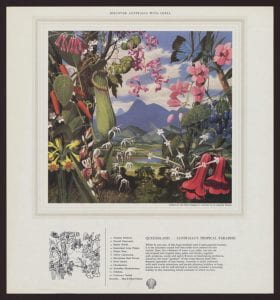Australia Discovered with Australian Wildflowers
Nasim Koohkesh
Australia has a significant diversity of wild plants and nature, so I used the title of ‘wildflowers’ to search the Shell Historical Archive for evidence of the presence of Australian wildlife in its mid-twentieth century pictures.
In a series called ‘Australia Discovered with Australian Wildflowers’, I found 12 pictures representing Australian vegetation in each state of Australia, including text and a list of the wildflowers represented. Sketched for Shell Australia in 1959 by the artist R. Malcolm Warner (1902-1966), The regions depicted in this series are listed below:
| No | Reference Code | Geological Location |
| 1 | 2008.0045.00297 | Queensland. |
| 2 | 2008.0045.00297 | Lamington National Park |
| 3 | 2008.0045.00297 | Northern Rivers; is the North-easterly region of Australia in the state of New South Wales. |
| 4 | 2008.0045.00297 | Ayers Rock (Uluru) in the Northern Territory |
| 5 | 2008.0045.00297 | Western Australia |
| 6 | 2008.0045.00297 | Tasmania |
| 7 | 2008.0045.00297 | The Snowy Mountains, in southern New South Wales, Australia, and is the tallest mountain range in mainland Australia |
| 8 | 2008.0045.00297 | Victorian Coast |
| 9 | 2008.0045.00297 | Grampians National Park in Victoria West |
| 10 | 2008.0045.00297 | South Australia |
| 11 | 2008.0045.00297 | Narrabeen lagoon in New South Wales |
| 12 | 2008.0045.00297 | The Victorian Alps, also known locally as the High Country, is an extensive mountain in the south-eastern Australian state of Victoria |
Each painting presents a landscape with a wild bouquet at the front of the image, and in addition, it provides brief description of the area’s geographical information and natural attractions. In images number 1, 5, 6 and 10, the painter has however had an entire state to depict and not introduced an exact geographical location. Furthermore, an index helps name the flowers in the image at the bottom of the page.

In total, the pictures illustrate 151 types of flowers, with only two species shared between three regions: the Native Convolvulus appears in the Lamington Gold Coast, Ayer’s Rock for the Northern Territory, and on the Victorian coast. Moreover, Correas appear on pictures of the Victoria Coast, Grampians National Park in Western Victoria, and the Victorian Alps. According to these digitised images, a common genus in Australia would be the Daisy and Orchid in different regions with various weather and soil conditions, showing in total eight separate species of Orchid, three reported in Queensland, and five species spread across Western and South Australia. Among the eight species of Daisy, three species grow in the Snowy Mountains and others are spread in other coastal and mountainous areas.
The genus Heath has five species, the Boronia, and Rose four species each, and they are spread in various regions from west to east and south. Finally, Bottle Brushes, Everlasting, Wattle, and Berry with three varieties in different colours seem to be the third most common flowers in the 1950s in Australia. Bottlebrush varieties are found in the southern regions such as South Australia, Victoria and Tasmania. Everlasting can be found from mountains to the coastal regions of Victoria. Wattle, however, is spread from West to East, while the Berry is only reported in Tasmania. Kangaroo Paws have two different colours, black and red, and occur naturally only in Western Australia.
Shell has chosen to represent unique flowers in each region, and perhaps to draw attention to flower species known in the 1950s due to their spread in each area. If placed alongside information from botanical databases and webpages , these pictures may help compare mainland Australia’s plant diversity during the mid-twentieth century with the present. The extent to which Shell’s posters also drew attention to the beauty of Australia’s plant diversity in the mid-1950s also helped to support a growing sense of pride in the uniqueness of Australia.
Nasim Koohkesh is a PhD student in Conservation of Cultural Materials at the University of Melbourne. Their research investigates the influencing factors in changing ultramarine blue colour in historical illuminated Persian manuscripts, through a focused case-based study of the Melbourne University Middle-Eastern Manuscript Collection.
Categories
- Uncategorised
- Special Collections
Leave a Reply